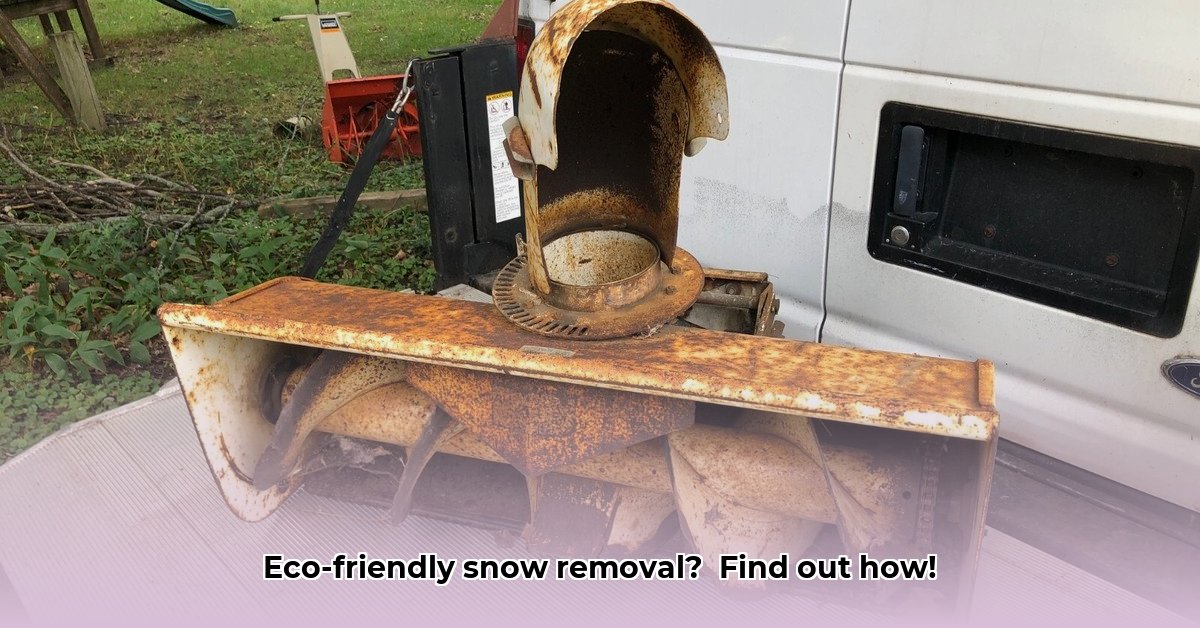
Let's face it: winter snow removal is a hassle, both physically and environmentally. But what if we could clear our driveways and sidewalks efficiently and sustainably? The Cub Cadet three-stage snowblower attachment promises faster snow removal, but does this speed translate to environmental friendliness? This article explores whether the purported efficiency gains of the three-stage model outweigh its potential environmental costs. For more on snowblower options, see this helpful resource.
The Three-Stage Snowblower: Speed Demons or Eco-Warriors?
Three-stage snow blowers, such as the Cub Cadet 42" model 1, are renowned for their speed, boasting up to 25% faster clearing than two-stage models. This suggests lower fuel consumption and reduced emissions due to shorter engine run times. However, this speed advantage doesn't automatically equate to environmental sustainability. A comprehensive assessment requires a lifecycle analysis (LCA), considering manufacturing processes, operational energy consumption, and end-of-life disposal.
Two-Stage vs. Three-Stage: A Sustainability Perspective
Comparing two-stage and three-stage snow blowers from a sustainability standpoint necessitates a nuanced approach. While three-stage models excel in heavy snowfall (18 inches or more), their advanced design demands more materials and energy-intensive manufacturing. Two-stage models, while slower, are generally more affordable, simpler to maintain, and may have lower overall energy needs for typical residential use. The critical question remains: does the time saved by a three-stage blower genuinely offset its potentially higher energy use and possibly shorter lifespan? Current data is insufficient to definitively answer this.
| Feature | Two-Stage Snowblower | Three-Stage Snowblower | Environmental Considerations |
|---|---|---|---|
| Clearing Speed | Slower | Significantly faster | Reduced engine runtime potentially lowers emissions and fuel use |
| Energy Consumption (use) | Higher (longer run times) | Lower (potentially) | Requires detailed, empirically-based studies for accurate assessment |
| Material Usage | Less complex design, fewer materials used | More complex, more materials required | Higher initial environmental footprint due to greater resource demand |
| Maintenance Complexity | Generally simpler | Potentially more intricate | Impacts overall environmental cost throughout machine's lifespan |
Beyond the Blower: Accessories and Environmental Impact
Accessories like tire chains, rear weights, and snow cabs significantly impact both efficiency and the environmental footprint. Chains and weights improve traction and stability, potentially lowering energy consumption during operation. However, their production and disposal should be incorporated into a holistic LCA. A snow cab, while enhancing operator comfort and potentially permitting longer periods of use, also increases material usage and manufacturing demands.
Lifecycle Assessment: The Missing Data
A complete lifecycle assessment (LCA) is essential for understanding the true sustainability of any product, including snow blowers. An LCA tracks environmental impacts across the product's entire life cycle, from raw material extraction to disposal. Currently, readily available comprehensive LCAs for three-stage snow blowers are scarce, hindering informed decision-making about their environmental impact.
Stakeholder Responsibilities: A Collaborative Approach
Sustainable snow removal requires a collective effort. Snow removal professionals must optimize machine operation and proper maintenance. Manufacturers need transparency, providing detailed LCAs. Governments can incentivize and regulate sustainable technologies. Consumers, too, play a vital role by making informed purchasing decisions, prioritizing brands committed to environmental responsibility.
Future Trends and Regulations
Evolving emission standards and noise pollution regulations will drive innovation toward more efficient and quieter machines. This is a positive trend, yet it requires close consideration of material innovation and potential lifecycle consequences. The industry needs to find a balance between enhanced performance and minimized environmental impact.
Key Takeaways:
- While three-stage snow blowers offer speed advantages, their overall environmental impact remains unclear due to a lack of available data.
- A comprehensive lifecycle assessment (LCA) is crucial for evaluating the true sustainability of these machines.
- A collaborative approach involving manufacturers, consumers, and governments is necessary to promote more sustainable snow removal practices.